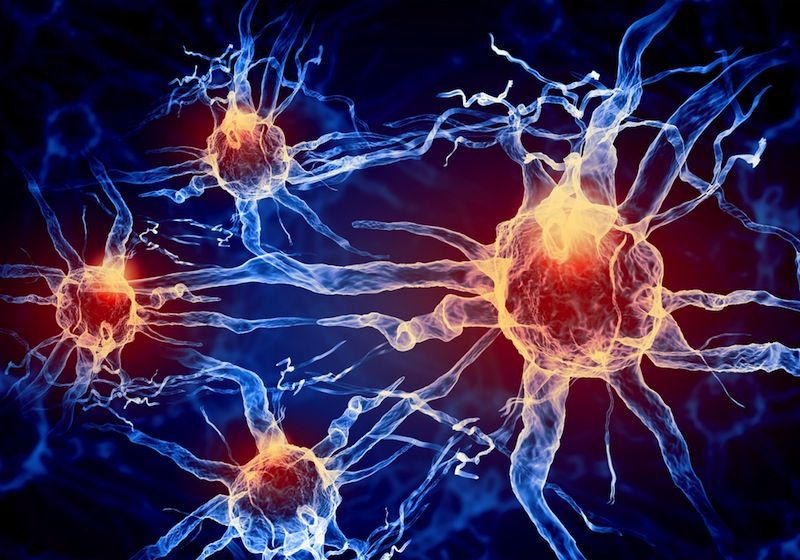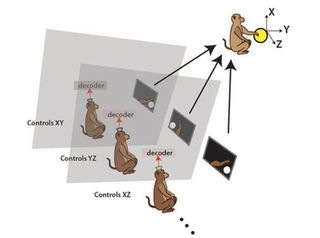Real-Life Mind Meld? Scientists Link Animal Brains

Resistance is futile — scientists are now one step closer to the Borg of "Star Trek," wiring brains together into "brainets" that can solve problems as teams, new experiments with monkeys and rats suggest.
The researchers say these so-called brain-to-brain interfaces could lead to "organic computers" made of multiple animal brains wired together.
Scientists worldwide are developing brain-machine interfaces through which people and lab animals can control robotic arms and exoskeletons using only their minds. These work by converting brain signals to computer signals and vice versa. [10 Things You Didn't Know About the Brain]
Recently, neurobiologist Miguel Nicolelis at Duke University Medical Center and his colleagues developed the first brain-to-brain interfaces, arrays of microscopic wires implanted in the brains of rats that allowed real-time intercontinental transfer of data between pairs of the rodents. One set of rats would learn to solve movement- or touch-based problems, and their brain activity was recorded as patterns of electrical stimulation that were transferred into the brains of another set of rats, helping the recipient animals solve those problems more quickly.
Now, Nicolelis and his colleagues have used brain-to-brain interfaces to create what they call brain networks, or brainets, that can work together to complete simple tasks.
In one set of experiments, the scientists linked rhesus macaque monkeys together into either a two-brain brainet, a B2, or a three-brain brainet, a B3. The primates all sat in separate rooms, sharing brain activity relating to their senses and movements.
The researchers next had the monkeys control the movements of a realistic virtual monkey arm on a video display. The amount of control each primate had over the arm depended on the experiment. For example, in one experiment, the monkeys in a B2 could each control only one of two dimensions of the arm's movement (such as up and down, or left and right), while in another, the monkeys in a B3 could each control two of three dimensions of movement (towards and away, for example).
Sign up for the Live Science daily newsletter now
Get the world’s most fascinating discoveries delivered straight to your inbox.
If the monkeys successfully guided the arm to touch a moving target, they got a small reward of juice. The scientists found that with long-term training, the monkeys increasingly coordinated their behavior and synchronized their brain activity, leading to improved performance.

In another set of experiments, the researchers connected three or four adult rats into a brainet to solve basic computational problems. The scientists first implanted arrays of microscopic wires in the primary somatosensory cortex of the rats, the brain region linked with the sense of touch. They next showed they could mildly electrically stimulate this part of the brain, generating what Nicolelis said was probably a tactile feeling of some kind. [5 Crazy Technologies That Are Revolutionizing Biotech]
In one experiment, when given this stimulation cue, thirsty rats learned they could get water if they synchronized the electrical activity of their brains. It's not known what exactly the rats do to change their brain activity, Nicolelis said.
Over time, rat brainets learned how to complete the simple computational task of pattern recognition. The rats recognize different patterns of brain stimulation, synchronizing their brain activity when they received one kind of stimulus and desynchronizing it if they received another, the researchers said.
The study revealed that such pattern recognition skills could be used to predict an increased or decreased chance of rain. The rats received patterns of electrical stimulation that represented increasing or decreasing air temperature and increasing or decreasing air pressure. Decreasing air pressure and increasing air temperature often signal early evening spring thunderstorms in North Carolina, where the research took place. The brainets predicted the chance of rain with 41 percent accuracy, much higher than chance, and better than single rats that received this data.
"The rats could divide tasks across animals, so their individual workload was much smaller," Nicolelis said. "We didn't expect that in the beginning."
One potential clinical application of this research is to link paralyzed patients with healthy volunteers to help them learn how to move again, or help patients learn how to control robotic limbs or exoskeletons, Nicolelis said.
"We hope to be able to report data on such research in a few months," Nicolelis said. "One day this could also help stroke patients, epilepsy patients and patients with other neurological disorders. Also, this could be done non-invasively, instead of having to use implants like we did in our experiments with monkeys and rats."
The scientists detailed their findings online today (July 9) in two studies in the journal Scientific Reports.
Follow us @livescience, Facebook & Google+. Original article on Live Science.

Most Popular




